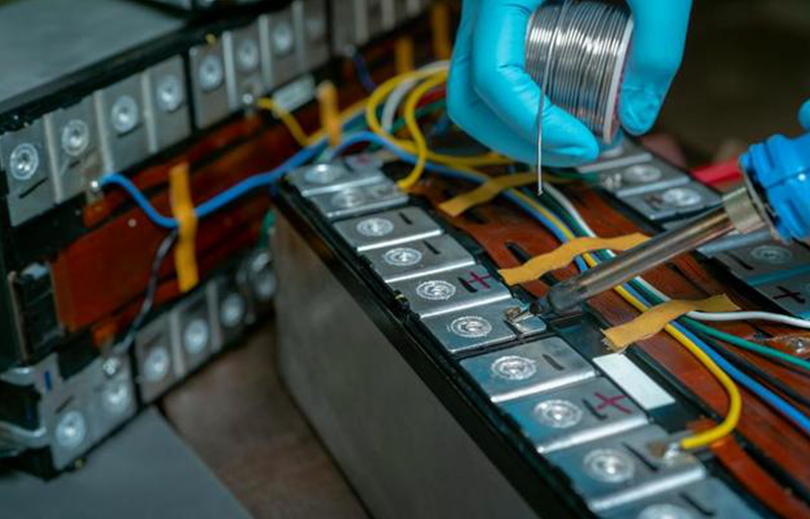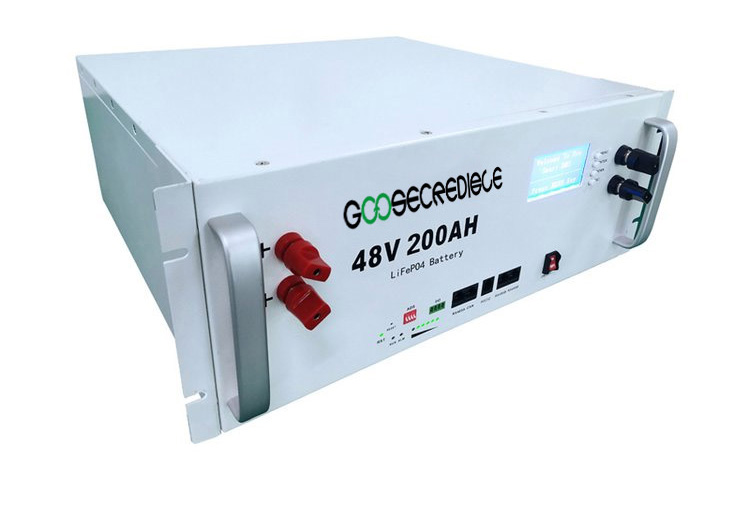Lithium Iron Phosphate Battery: In-depth Analysis of its Technical Principles and Characteristics
Lithium iron phosphate battery, as an important type of lithium-ion battery, has occupied a place in the field of energy storage since its birth due to its unique performance advantages. This article will thoroughly analyze the technical principles, structural characteristics and significant features of LFPB, but will not cover specific application areas and future prospects.
Technical Principles and Structural Features
The lithium iron phosphate battery, whose full name is lithium iron phosphate lithium-ion battery, is based on the use of lithium iron phosphate (LiFePO?) as the positive electrode material, while the negative electrode is usually made of carbon (graphite) material. The design of this battery allows its single cell nominal voltage to reach 3.2V, and the charge cut-off voltage is controlled between 3.6V and 3.65V.

From the perspective of battery structure, the left side of the lithium iron phosphate battery is the olivine-structured LiFePO? positive electrode material, which is connected to the positive electrode of the battery by aluminum foil; the right side is the carbon (graphite) negative electrode, which is connected to the negative electrode of the battery by copper foil. In the middle is a polymer separator, which effectively separates the positive electrode from the negative electrode, but allows lithium ions to pass through, but not electrons. The battery is filled with electrolyte and sealed with a metal case to ensure the safety and stability of the battery.
During the charging and discharging process, the operating principle of lithium iron phosphate batteries depends on the migration of lithium ions. During charging, some lithium ions in the positive electrode LiFePO? are released, transferred to the negative electrode through the electrolyte and embedded in the carbon material of the negative electrode; at the same time, the electrons released from the positive electrode flow to the negative electrode through the external circuit to maintain the balance of the chemical reaction. During discharge, the process is reversed. Lithium ions are released from the negative electrode and return to the positive electrode through the electrolyte. At the same time, electrons are released from the negative electrode and flow to the positive electrode through the external circuit to supply energy to the outside world.
Key Features
Lithium Iron Phosphate battery can stand out among many lithium-ion batteries mainly because of the following significant features:
High operating voltage and high energy density: The single cell nominal voltage of LFPB reaches 3.2V, and it has high energy density, which means it can store more electrical energy in the same volume or weight.
Long cycle life: Compared with other types of lithium-ion batteries, lithium iron phosphate batteries have a longer cycle life, generally reaching more than 2,000 times, and even more than 3,500 times under certain conditions. This long life characteristic makes it more advantageous in situations where frequent charging and discharging is required.
Excellent safety performance: The P-O bond in the lithium iron phosphate crystal structure is stable and difficult to decompose. Even under high temperature or overcharge conditions, it will not easily experience thermal runaway or form strong oxidizing substances like materials such as lithium cobalt oxide. This makes lithium iron phosphate batteries particularly safe.
Low self-discharge rate and no memory effect: The self-discharge rate of lithium-iron-phosphate batteries is relatively low, and there is no common memory effect such as nickel-metal-hydride and nickel-cadmium batteries. This means that users can charge and discharge the battery at any time without worrying about the loss of battery capacity.
Environmentally friendly: Lithium Iron Phosphate batteries do not contain any heavy metal elements that are harmful to the human body and are considered to be green and environmentally friendly battery products. It complies with European RoHS regulations, does not pollute the environment, and meets the current global requirements for energy conservation, emission reduction and sustainable development.

Technical Challenges and Improvement Directions
Although lithium iron phosphate batteries have many advantages, they also face some technical challenges. These include poor performance at low temperatures, low tap density of positive electrode materials, and high material preparation and battery manufacturing costs. To overcome these challenges, researchers are constantly exploring new synthesis methods and modification technologies to improve the overall performance of LFP batteries.
In summary, as an important type of lithium-ion battery, lithium iron phosphate battery has wide application prospects in the field of energy storage. With the continuous advancement of technology and further cost reduction, it is believed that LFPB will bring its unique advantages to more fields.
-
 A portable car jump starter battery charger booster starter is an essential tool for any car owner. It is a device that can be used to jump-start a car battery that has died or is weak. It is a compact and portable device that can easily fit in the trunk of your car, making it easily accessible whenever you need...Read more
A portable car jump starter battery charger booster starter is an essential tool for any car owner. It is a device that can be used to jump-start a car battery that has died or is weak. It is a compact and portable device that can easily fit in the trunk of your car, making it easily accessible whenever you need...Read more -
 The world has witnessed a significant transformation in the energy sector. The rise of renewable energy sources and the increasing demand for clean and sustainable power have led to the development of smart grids. These intelligent electricity networks enable efficient energy management, real-time monitoring, and optimal utilization of resources. One key component that has played a crucial role in the...Read more
The world has witnessed a significant transformation in the energy sector. The rise of renewable energy sources and the increasing demand for clean and sustainable power have led to the development of smart grids. These intelligent electricity networks enable efficient energy management, real-time monitoring, and optimal utilization of resources. One key component that has played a crucial role in the...Read more -
 Introduction: In today's world, where portable electronic devices and renewable energy sources are becoming increasingly prevalent, the demand for efficient and long-lasting power sources is on the rise. One such power source that has gained significant attention is the 12V 100AH LiFePO4 battery. Known for its exceptional performance and durability, this battery has revolutionized the way we power our devices...Read more
Introduction: In today's world, where portable electronic devices and renewable energy sources are becoming increasingly prevalent, the demand for efficient and long-lasting power sources is on the rise. One such power source that has gained significant attention is the 12V 100AH LiFePO4 battery. Known for its exceptional performance and durability, this battery has revolutionized the way we power our devices...Read more -
 To charge a Lithium Iron Phosphate (LiFePO4) battery, follow these general steps: Use a charger specifically designed for LiFePO4 batteries, as this type of battery has a different charging profile than other lithium-ion batteries. Connect the charger to the battery, making sure the polarity is correct. Set the charger to the appropriate charging voltage and current for your specific battery....Read more
To charge a Lithium Iron Phosphate (LiFePO4) battery, follow these general steps: Use a charger specifically designed for LiFePO4 batteries, as this type of battery has a different charging profile than other lithium-ion batteries. Connect the charger to the battery, making sure the polarity is correct. Set the charger to the appropriate charging voltage and current for your specific battery....Read more -
 Lithium Iron Phosphate (LiFePO4) batteries are a type of rechargeable battery that are known for their high energy density and long cycle life. They are commonly used in electric vehicles, energy storage systems and portable devices. One important factor that affects the performance of LiFePO4 batteries is temperature. Like all batteries, LiFePO4 batteries have a temperature range in which...Read more
Lithium Iron Phosphate (LiFePO4) batteries are a type of rechargeable battery that are known for their high energy density and long cycle life. They are commonly used in electric vehicles, energy storage systems and portable devices. One important factor that affects the performance of LiFePO4 batteries is temperature. Like all batteries, LiFePO4 batteries have a temperature range in which...Read more -
 For those who love to have outdoor adventures, a reliable power source is a must-have. In the past, people had to rely on gasoline generators to provide power when they were in the wilderness. However, the advent of emergency starter batteries has revolutionized the way we power our devices during an emergency situation. An emergency starter battery is a...Read more
For those who love to have outdoor adventures, a reliable power source is a must-have. In the past, people had to rely on gasoline generators to provide power when they were in the wilderness. However, the advent of emergency starter batteries has revolutionized the way we power our devices during an emergency situation. An emergency starter battery is a...Read more -
 Introduction: In recent years, the agricultural sector has witnessed a significant revolution in terms of technological advancements. One such revolution has been the development and use of high-power lithium batteries. These batteries have transformed the way agricultural tools and equipment function, providing farmers with greater efficiency, productivity, and sustainability. This article aims to explore the impact of high-power lithium...Read more
Introduction: In recent years, the agricultural sector has witnessed a significant revolution in terms of technological advancements. One such revolution has been the development and use of high-power lithium batteries. These batteries have transformed the way agricultural tools and equipment function, providing farmers with greater efficiency, productivity, and sustainability. This article aims to explore the impact of high-power lithium...Read more

